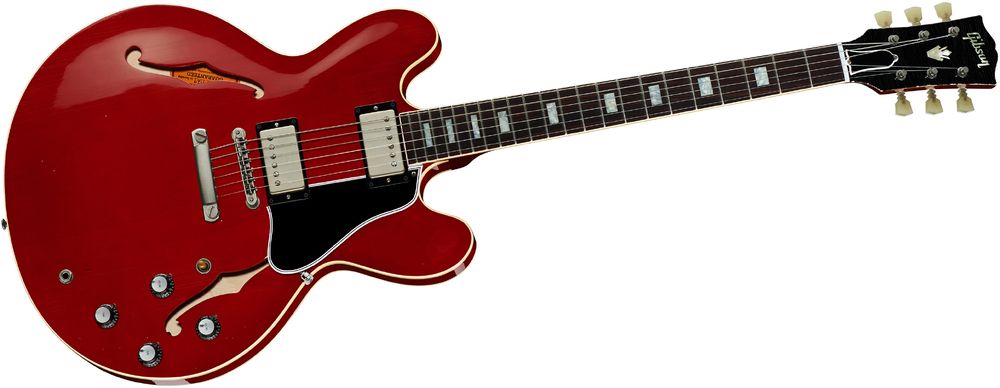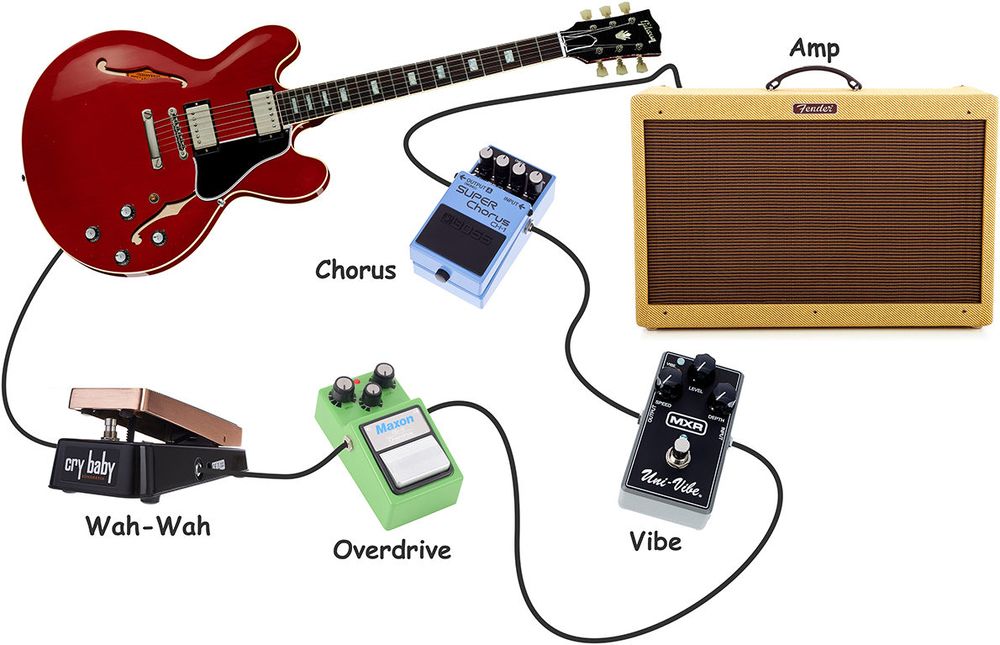2. The Blues Setup
Guitar
There isn't exactly a "blues guitar," but over the decades, certain models have emerged as enduring favorites:
On one hand, there's the B.B. King school, which banks on the rich, singing tones of semi-acoustic models (primarily the ES 335 types). On the other end, there are the edgy sounds of the Stratocaster, often used by blues guitarists (from Buddy Guy to Eric Clapton, SRV, or Robert Cray).
But (to make it very clear again): Good blues sounds and legendary recordings have been made with all other guitar types as well!

Item No. 141524 - Epiphone The Dot
Amp:
For lovers of traditional blues sounds, it's essential to hear as much of the guitar's original tone as possible. Too much distortion isn't usually desired as it might swallow the nuances in playing and dynamics. What's needed is an expressive, sustaining tone.
Therefore, the base sound is generally derived from a cleaner tube amplifier. If a bit of distortion is required, the amp is turned up accordingly. Specifically, we're talking about power amp distortion, which sounds much bluesier and less "fuzzy" than the more modern preamp variant. Ideal options here are tube combos (1x12, 2x12, or even 4x10; the larger black boxes suit the "bad boys" better) without a master, but with a reverb unit. However, the clean channel of a multi-channel amp can also deliver the desired results - with the master (if available) turned up, adjust the gain/volume as needed. If the distortion at full volume isn't enough or if you want a decent "crunch" even at a safe level - up to lead sound - an overdrive pedal comes into play.
Effects:
The Overdrive:
Depending on preference, it can serve two functions:
- Overdrive Sound: Adjust the distortion level to taste. Use the volume knob to determine the balance with the bypass sound.
- Primarily used as a booster: Here, the sound isn't overly or not at all distorted, but the volume is increased, giving the amp more "kick." This is ideal for amps that don't distort much. A tap on the pedal and you have a harmonically balanced and sustainable lead sound that still resembles your favorite amp.
Of course, for most blues guitarists, a usable Wah-Wah pedal is also essential - the traditional version is more suitable for blues. More about this can be found in our Floor Effects Online Guide.
Perhaps no longer for the blues purists, but more for fans of the "late '60s psychedelic blues school": A vibe pedal (Hendrix, Robin Trower; Steve Ray Vaughan occasionally used one too, mostly a real Leslie cabinet) was originally designed to mimic the sound of a rotating Leslie cabinet. However, it has a very distinctive sound of its own, making it hard to compare to today's common digital Leslie simulations. It's perhaps closest to a mix of Leslie, Phaser, and Stereo Chorus. In any case, this unique effect can only be achieved in this particular way.
As these pedals are still quite expensive, a chorus pedal or a phaser can be used as an alternative.
A good dose of reverb is also part of the typical blues sound, usually coming from the amp's spring reverb.
Sounds:
- Clean Sound: Since the amplifier (for power amp distortion) needs to be turned up quite high, one must adjust the volume knob on the guitar according to preference (true clean isn't really desired in blues). With plenty of reverb and perhaps some modulation, this setup is suitable for accompanying quieter pieces, yet can also be used for solos (Robert Cray, Peter Green, SRV). This sound is brutally honest and doesn't forgive any sloppy playing!
- Crunch: In most cases, just turning up the volume knob should suffice, but you can also activate the overdrive and dial back the volume knob. Steve Ray Vaughan frequently used this approach, with his Tubescreamer on most of the time. Equally suitable for blues riffs and solos.
- Lead Sound/Distorted Sound: This simply refers to the distorted version; as mentioned, the other versions are also suitable for solos. Just turn on the overdrive and adjust the guitar's volume.
Of course, the suggested effects can be used with all versions; distorted floating vibes à la Hendrix, SRV, and Robin Trower sound particularly great.




